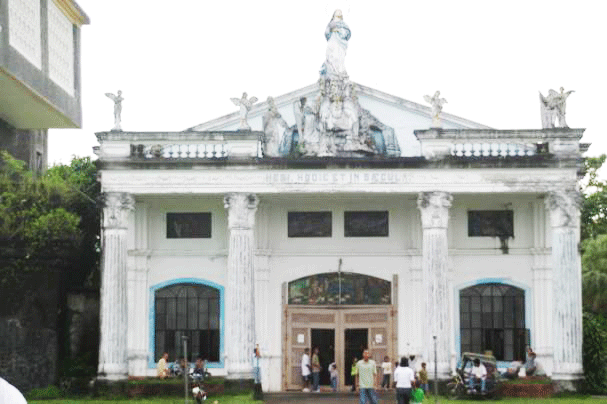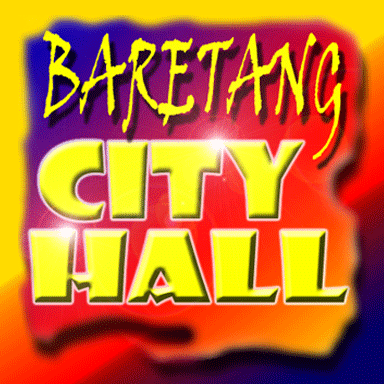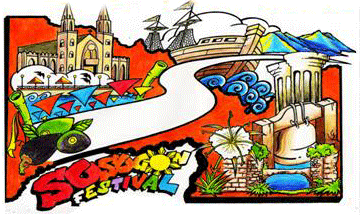Getting
there....
By PLANE:
The
fastest way to reach Sorsogon City is by plane, via Manila-Legazpi
City. From Manila, Legazpi City is just 45-minutes away. From Legazpi City
Airport, public transport utilities like buses and passenger vans are
available to take you to Sorsogon City. The ride takes about one hours or
less.
By BUS:
The most common means of travel to
Sorsogon City is by bus. Travel time from Manila is approximately
8-10 hours. There are several buses plying Manila-Sorsogon route and
vice-versa range from air-conditioned to ordinary.


BACON: Oldest
Pueblo Civil of Sorsogon.
In the year 1609, The Fanciscans founded the settlement of Bacon, which
later became a visita or barrio, and in 1617, it was separated from
Casiguran to become an independent parish, which included Sta. Florentina
(now Rapu-rapu), and Montupar (now Prieto-Diaz). Bacon's patroness was Our
Lady of the Annunciation, until Fray Gregorio Sta. Ana replaced it with
Sta. Rita de Casia. In 1853, however, Fray Remigio de Vera returned the
Our Lady of the Annunciation, as patroness of the parish, up to the
present time. Bacon is the oldest municipality (pueblo civil) of the
province. It was founded in 1754. It is also the nearest town to the
capitol town of Sorsogon, with a distance of only nine kilometers. The
road connecting it is the oldest in the province. The municipality of
Bacon (Now Bacon District, City of Sorsogon), as established by the
Spanish government then, included under its jurisdiction the barrios of
Sta. Florentina, Batan and Cagraray islands. When Sorsogon became an
independent province from Albay, Bacon lost to Albay, Rapu-rapu, Batan and
Cagraray islands. Also, the barrios of Suwa and Cabit were lost to the
Municipality of Manito, also in Albay. Rapu-rapu became a municipality of
Albay in 1901, while Prieto-Diaz was separated from Bacon in 1904, to
become an independent municipality. With the separation of sorsogon from
Albay, the boundaries separating them were moved from Balabagan to Suwa.
The Sorsogon-Bacon Bridge. Bacon was
an important port during the Spanish period until the opening of the
Sorsogon-Albay road in 1924. Government officials, businessmen and
travelers from Manila used to come to Legaspi by train, and from Legaspi
to Bacon, by the launch, San Antonio, and from Bacon to Sorsogon, by bus.
Due to the importance of the port in business, and the road, in
transporting goods from Bacon to Sorsogon, Governor Peņaranda of Albay
issued a decree in 1814 ordering the construction of Gabao Bridge, to be
finished in forty-five days by polistas. One-half of the bridge, on the
Bacon side, was constructed by polistas from Bacon, and the other half
from Sorsogon (Unfortunately, this bridge is no longer there, having given
way to the widening of the concrete roadway going into Bacon, which
is now a mere district of Sorsogon City)
Fr. Isidoro Dino
Taken from the book of "Tracing from Solsogon to Sorsogon Second Edition
page20.
Sorsogon Education
Known as one of the most
progressive second-class provinces within the southern region of the
Philippines, Sorsogon features high standard universities and colleges
that comprise its outstanding education system. In order to teach students
in the most efficient way possible, these schools offer first-rate
academic programs. By offering high quality education without compromising
the quality of education, many students love to enroll at these premier
schools. More importantly, these wonderful colleges and universities have
extensive scholarship programs in-stored for everyone.
Facts & Figures
Location: Region V, also
known as the Bicol Region
Cities: 1 (Sorsogon City, the capital)
Population: approx. 700,000
Representation in Congress: 2
Municipalities: 14
The influence of the
Spaniards can be readily seen in the fact that most of the inhabitants are
Roman Catholics, and this is reflected by the numerous festivities
dedicated to various saints and patrons. However there are also several
minorities, including the Muslims. In Sitio Bolangan is a well known
mosque, frequented by devotees. There are also some Chinese and Hindus,
mostly in the capital where they are engaged in various businesses.
Language
Virtually everyone in the
province can comprehend and speak Tagalog, and also Bicolano, but it is
interesting to note that there exists a wide array of “local” dialects,
which differ somewhat from district to district. This does not just refer
to the distinctions between the Biocalno and Bisakol language; the Bisakol
(also termed Waray) used in places like Satan Magdalena, Bulusan and Gubat
are not the same as those spoken in Magallanes, Sorsogon City and Juban.
Some also speak Cebuano and of course English is utilized in schools, and
people, particularly in the capital, use it very well.



